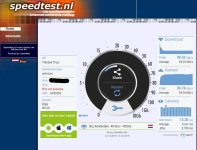NewAlkyogre
Active member
- Thread Author
- #1
A difficult question: Looking for another streamer. I am struggling for a long time. It did get my interest when going to an audio show from Silent Angel. Silent Angel was very well known by their audiophilic switches, which they started with the Silent Angel Bonn I use, combined with a lineair forester power supply. Nowadays their newest versions have a better build, and are also equipped with an input for external clocks and this matter makes a lot of sense. What is the issue? The internet is a collection of all servers which creates all kind of timing errors: called jitter. As we all know: jitter is hearable and is the major enemy in audio streaming. How much jitter are we talking about? To measure that the internet site speedtest.nl is used Speedtest.nl -. The amount of jitter varies a bit, at the moment this picture was taken, jitter was 0,700 ms. Doing nothing with that jitter still leaves an output of 0.700 ms, even when a great streamer is used.

Because we all are connected to internet servers, we all face the same issue, the input signal from outside the house contains jitter
What are possible solutions for that?
Number one: is using a USB connection from the streamer to the dac. A toslink, or coax are ones and zero's and the difference with USB is that the latter one sends data packages and information which will later be translated in a jitter free digital signal. How effective is this? And moreover, the streamer has also an internal clock, which introduces again some timing errors.
Secondly what Silent angel does: it has a separate clock input from all streamers and switches which makes the ethernet connection free from all timing errors. My thing is that you have to stick with their hardware. All motherboards, switches etcetera don't have such an external clock input which makes the more hobby DIY self build unusable. But what I prefer is the less is more method: they use a separate Roon core and Roon streamer. I like to go for a shorter way, hooking directly a dac to the Roon server, in which the switch and the Roon core are external clocked. There are computer boards that can be clocked external, but they are not powerful enough for a Roon core, or they are far away out of my budget.
Finally: are there other suggestions: There are more brands with an external clock input, so that also would be a nice option.

Because we all are connected to internet servers, we all face the same issue, the input signal from outside the house contains jitter
What are possible solutions for that?
Number one: is using a USB connection from the streamer to the dac. A toslink, or coax are ones and zero's and the difference with USB is that the latter one sends data packages and information which will later be translated in a jitter free digital signal. How effective is this? And moreover, the streamer has also an internal clock, which introduces again some timing errors.
Secondly what Silent angel does: it has a separate clock input from all streamers and switches which makes the ethernet connection free from all timing errors. My thing is that you have to stick with their hardware. All motherboards, switches etcetera don't have such an external clock input which makes the more hobby DIY self build unusable. But what I prefer is the less is more method: they use a separate Roon core and Roon streamer. I like to go for a shorter way, hooking directly a dac to the Roon server, in which the switch and the Roon core are external clocked. There are computer boards that can be clocked external, but they are not powerful enough for a Roon core, or they are far away out of my budget.
Finally: are there other suggestions: There are more brands with an external clock input, so that also would be a nice option.




